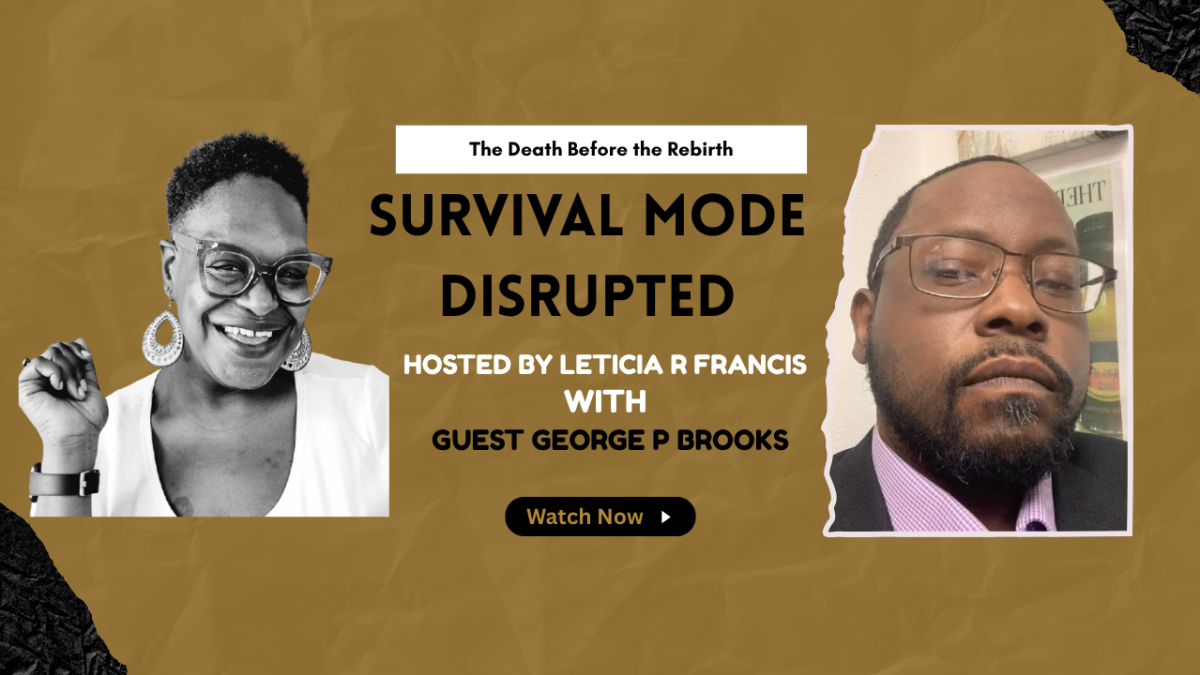The Death Before the Rebirth

George P. Brooks on addiction, accountability, and rebirth—how facing his pain turned survival into purpose.
There’s a moment every survivor remembers—the moment life stops whispering and starts screaming: “Change, or this will kill you.”
For George P. Brooks, that moment came after years of chaos: bipolar disorder, addiction, homelessness, and a decade-long depression that nearly ended his life.
But this isn’t a story about drugs.
It’s a story about resurrection—about what happens when a man decides to stop dying slowly and start living intentionally.
It’s about the truth that sits beneath every addiction: unprocessed trauma, unspoken pain, and the desperate need to feel safe—if only for a few minutes.
George’s journey through survival mode is one of the most raw examples of what it looks like to fall, face yourself, and rise again.
And just like every story of transformation, it unfolded through the three phases of exiting survival mode: Self-Awareness, Reprogramming, and Reinvention.
Phase 1 — Self-Awareness: Facing the Unhealed Wound
Addiction isn’t the disease—it’s the symptom.
For George, the real sickness started long before the first line of cocaine.
It began in childhood—with emotional trauma, a failing school system, and a mental-health diagnosis he never received the right support for.
By the time he was twenty-three, he’d done everything “right.”
College. Marriage. Home ownership.
But inside? He was crumbling.
Unaddressed pain doesn’t disappear—it metastasizes.
And when you’re carrying untreated bipolar disorder, unhealed trauma, and a lifetime of pressure to hold it all together, the brain starts looking for relief.
That’s how survival mode sneaks in—it doesn’t always arrive as panic. Sometimes it arrives as performance.
Cocaine became his coping mechanism, not his thrill.
He wasn’t chasing a high; he was chasing silence.
When he finally looked in the mirror and said, “I did this. No one else—me,” that’s when awareness cracked open the door.
True healing begins the day you stop blaming the world for your wounds and start asking what you can do to stop bleeding on yourself.
Phase 2 — Reprogramming: The Grind of Accountability
There’s nothing glamorous about recovery.
George spent his first thirty days flat on his couch—alone, sweating through withdrawal, sick with the flu, and sicker with shame.
That’s the part people don’t talk about.
Healing isn’t a highlight reel; it’s an exorcism.
Every craving, every memory, every regret tries to pull you back into the familiar.
Because even pain feels safe when it’s predictable.
But George did something most people avoid—he took radical ownership.
He stopped waiting for someone to save him and decided to save himself.
“No one’s coming,” he said. “I’m responsible for how I feel.”
That sentence changed everything.
Accountability isn’t about punishment—it’s about power.
It’s about reclaiming the steering wheel of a life you once crashed.
He started therapy. He took his medication. He built structure around his bipolar disorder the same way you’d build a scaffolding around a fragile building—because healing doesn’t erase the cracks, it reinforces the foundation.
And he learned that recovery is not an event; it’s a discipline.
It’s choosing yourself again and again, especially on the days when self-destruction feels easier.
Phase 3 — Reinvention: The Rebirth After the Ruin
Recovery, like healing, demands death before resurrection.
George had to bury his coping mechanisms, his codependent relationships, and the version of himself who believed chaos was love.
He lost friends.
He distanced from family members who enabled his pain.
He moved 500 miles away from home to save his own life.
And in the silence of that distance, something new was born.
He founded The Metta Association, a nonprofit focused on Black mental health, fatherhood, and reducing recidivism.
He became the mentor he never had—the voice telling men it’s okay to feel, to falter, and to heal.
Because representation matters.
Black men are often taught to endure, not emote. To lead, but never lean.
George became living proof that vulnerability is not weakness—it’s warrior work.
He teaches men the difference between reacting and responding.
He reminds them that peace is not boring; it’s freedom.
And he’s building safe spaces so they never have to break in silence again.
That’s what reinvention looks like—when pain becomes purpose and survival turns into service.
The Lesson: Patience, Accountability, and the Power of Rebirth
Exiting survival mode isn’t about becoming someone new.
It’s about remembering who you were before the world told you to hide.
George’s story reminds us:
-
Self-Awareness begins when you stop pretending and start looking inward.
-
Reprogramming happens when you own your role in your reality.
-
Reinvention begins the moment you choose peace over performance.
He says it best:
“Be patient with yourself. You’re not behind—you’re becoming.”
Every day of healing is a choice.
Every act of accountability is a step toward freedom.
You weren’t built to break.
But you damn sure weren’t built to just survive.
Categories: : Podcast
START HERE: YOUR SURVIVAL MODE EXIT PATH
Step 1: Awareness & Understanding
Survival mode isn’t just exhaustion—it’s a cage that tricks you into believing struggle is normal. The longer you stay in it, the harder it is to recognize that life was never meant to feel this heavy.
Step 2: Take the First Step
You’ve spent years surviving—now it’s time to unlearn the patterns that have kept you stuck. Download your FREE Survival Mode Exit Blueprint to uncover the hidden cycles running your life and take your first bold step toward transformation.
Step 3: Listen & Learn
Real stories. Raw truths. No sugarcoating. The Survival Mode Disruption Podcast brings you the voices of survivors and experts who have disrupted survival mode and built a life on their terms—because if they can do it, so can you.
Step 4: BUY The Book
Survival Mode Exit Plan is not another fluffy self-help manual. It’s not about manifesting your way into freedom or faking positivity through pain. It’s a punch-in-the-gut, hold-up-a-mirror kind of book.
Step 5: Get Support
You don’t have to do this alone. Inside the Survival Mode Exodus Membership, you’ll get the deep guidance, strategy, and accountability needed to fully step into your power and stop playing small.
Step 6: JOIN THE MOVEMENT
Survival mode is a lie, and it’s time to disrupt it—together. Connect with a growing community of women who refuse to settle for struggle, subscribe to the Survival Mode Disrupted Newsletter, and take your seat at the table of transformation.
 Leticia Francis
Leticia Francis 
